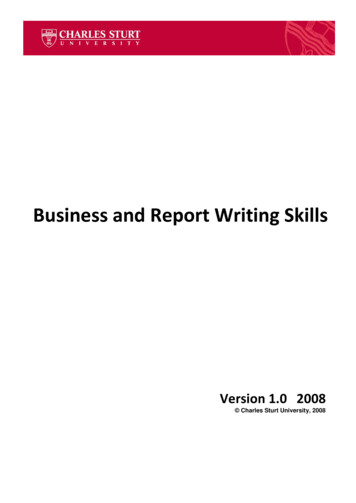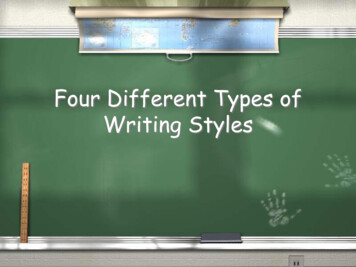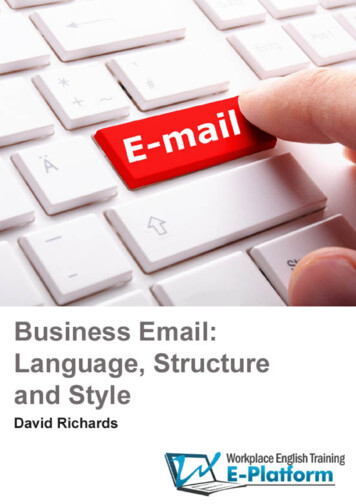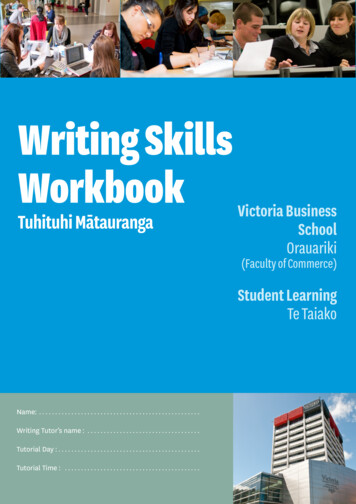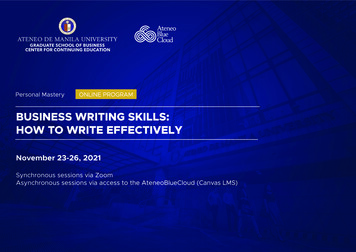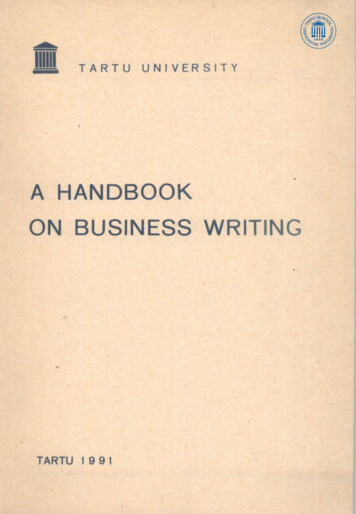
Transcription
LTARTU UNIVERSITYA HANDBOOKON BUSINESS WRITINGTARTU19 9 1
TARTU UNIVERSITYDepartment of EnglifhA HANDBOOKON BUSINESS WRITINGCompiled by A. M. VeskisTartu 1991
Kinnitatud filoloogiateaduskonna noukogus23, Jaanuaril 1991.Retsenseerinud H. LiivKUSTUTATUB ,Tartu ÜlikooliRA AM ATUKOG' Aire e Veskis, 1991
CONTENTSБ геГасе4IntroductloaSeader-Focueed WritingбPreparation ActivitiesThe Writiag Process810Style135Forms of Technical WritingAbstracts1?ReTiewsBusiness Letters1820Priaciples of Letter Writiag .i:Form of Business Letters2426The Letter of InquiryThe Letter of Applicatioa3 3 Model Cover Letter and Eeeune38MemorandumsProposalsEeports'Ч-0- 345Main Sources Used51
SSSPACS7he preseat advice oa effective writing Is latended tobe a study aid for the students specializingia Sngliahwho wish to Improve their writing skills in thebusiness.fieldofThe aim öf the booklet is to provide the students witbnecessary material concerning business or techoiealwrit ing. The booklet describes general principles of effectivewriting and discusses specific forms of business ornical writing such as abstracts, reviews, letters,teebrmemo randums, proposals, and reports.The booklet can be used by anydody who knowsBagllehand wants to develop his skills in business writing.Author4-
ШЕНОРиСТЮЯThe ability to write is aot something we arewith, we learn gradually, improving as we grow olderbecome better educated. As adults, we shouldbebornandabletowrite about many subjects and for many different kindsofreaders.There are several kinds of writing. One of them thatis frequently used is business or technical writing. Busi ness or technical writing is the writing we do in the fieldof work. Such writing is the only kindmostever deal with. Since our business relationsindividualswith othercountries have increased, the need for business correspon dence has also grown. In order to correspondeffectively,one should fpllow certain principles and conventions. Thisstudy aid focuses on them.There is no such thing as business English In Ше senseof a special mode of communication or any special use oflanguage. Business English ought to be simply the best Eng lish a writer is capable of using- as sinrple, direct, clear,and forceful as he can make it.The success of writing depends on several factors. Itis important to take into account the reader'sinterestsand know your objective in advance. The present study aiddescribes the preparation activities and the stages of thewriting process. It also gives advice on style.We often have to write for specificpurposes. Thisbooklet discusses how to write abstracts andreviews. Alarge section is devoted to business letters due to theneed to correspond with Western countries. The formofbusiness letters described ia the booklet is the one usedin the USA but also practiced in Scandinaviancountries.Other forms of business writing such as proposals, memor andums, and reports are perhaps used not so often in ourcountry yet, but may become more common with thechangingof the economy. The given exajnples are of American origin.Success in business and in any field of work greatlydepends on the ways we write. The current study aid atrtempts52
to help develop oae*s skills in performing different writ ing tasks.EB/LDBR-POCDBED WRITINGThe purpose of business writing is to inform yourreaderand to persuade the reader. Good writers do not simply ex press themselves, they design their writing to beunder stood and remembered. The writer's aim must be clearcom munication to his reader at the level of the reader's abil ity to understand» For example, most business letters areaddressed to one individual. Many reports, too,are re quested by one person and are prepared primarily for him.Abstracts and reviews are of particular interest to a rela tively homogeneous and limited group.The technical writer must know who his readers are andmust direct every word and detail to them. Even whenthewriter knows his audience, he must constantly ask "Forwhomam I writing?'*. "How does my audience affect mypresenta tion and style?", "What does my reader know?",andwill my reader benefit from this writing?"."HowHe must adapthis writing to his readers' experience and need.The ability to put yourself in another's place is cru cial to writing effectively. You should think aboutyourreaders before you begin to write, because your writingwill be shaped by your perceptions of whatyour readersneed to know about your topic» Before starting to write,you must determine who your readers are and then adjust theamount of detail to their training and е:ч?б1'1 о-С » Puttingyourself in your readers place should enable you to plan,right from the start, to answer any questions theymighthave about your topic or to explain things they are notlikely to know. If you hope to get your readers to agreewith you, or to change their minds on a controversial issue,you must be able to look at all sides of the issue andanswer the objections of those with a differentview.6pointof
As a technical writer, 70U must usually assumethatyour readers are less familiar than you are with theject. You should give definitions of technicalsub termswell as clear e2i)lanations of principles that you,asasaspecialist, take for granted. When you write for manyreaders, try to visualize a single, typical member of thatgroup and write for that reader. You might also make a listof characteristics (езфег1епсе, training, and workhabitsfor example) of that reader. This technique enables you todecide what should be explained according to that reader'sneeds. When you are writing to a group, it is usually bestto aim at those with the least training andезфвг1епсв.When your readership includes people with widely variedbackgrounds, however, such as in a report or proposal, con sider aiming various sections of the document at differentsets of readers.The style and tone should also be suitabletothereader's need and understanding. The writer should use atechnical vocabulary with which the reader is familiar, butusing any sort of vocabulary Just to exhibit it is alwayswrong. The use of pronouns and verbs and the whole stylis tic point of view should be appropriate to the reader. Theimperative mood and the so-called you-style are in orderonly when readers will actually carry out instructions. Ifthe reader is merely an observer, seeking informationsome purpose, the third person or a completelyforimpersonalstyle is far better. Letters written topersons outsideyour organization also require a special tone. In such letlers, you must concern yourself not only with the readers'understanding of your topic but with their reaction to itав well.A business writer always writes for his reader and tohis reader. In technical writing the writer-readerrela tionship is so vital that the success of the writingde pends on it. No matter what your topic or format is, neverforget that your readers are the most important consider ation, for the most eloquent prose is meaninglessit reaches its audience.72*unless
PHEPARATION AOTIVITIBSOb.iectlveAa important question to be answered before you beginwrite concerns your purpose for writing.Firstoftoall,you should define the objective of your writing by ansvering questions like "Why do I need this writing?", and"What do I want my readers to know or be able to do whenthey have read my finished writingproject?".Definingyour purpose in advance will help you choose what toclude and how to approach your subject. For example,in ifyou are writing for information on a product you are con sidering buying, you must be sure to езф1а1п your needsand expectations fully. If you are giving directions, youmust include all the necessary information,that would distract.andIt is of no use to state your objectiveterms. The writer's objective is rarely simplyplain" something, although on occasion it maymust ask yourself, "Why do I need toexplainnothingintobroad"ex be.Youit?". Inanswering this question, you may find, for example, thatyour objective is also to persuade your reader to changehis attitude toward the thing you are explaining.If you answer these two questions exactlyand putyour answers in writing as your stated objective, you wi.llbe considerably more confident of ultimately reaching yourgoal. As a test of whether you have adequately formulatedyour objective, try to state it in a single sentence. Ifyou find that you cannot, continue to formulate your ob jective until you can state it in a single sentence.Even a specific objective is of no value,however,unless you keep it in mind as you work. Guard againstlosing sight of your objective as you become involved withthe other steps of the writing process.8
ScopeIf you kaow your reader aad the objective of yourproject, you will kaow the type and amount ofwritiagdetailtoinclude in your writing. This is scope which may be definedas the depth and breadth to which you need to cover yoursubject. If you do not determine your scope of coverage inthe planning stage of your writing project,youwill notknow how much or what kind of information to include.Your scope should be designed to satisfy the needs ofyour objective and your reader. By keeping yourobjectiveand your reader's profile in mind as you work, you can de termine those items that should be included in yourwrit ing.Format has at least two distinct, but related ings: it can refer (I) to the sequence in whichmean informa tion is presented in a publication, and (2) to thephysi cal arrangement of information on the page. The first mean ing applies to the standard arrangement ofinformation inmany of the following types of job-related writing: formal reports proposals reports memorandums correspondence resumesThese types of writing are characterized by format conven tions that govern where each section will be placed. Informal reports, for example, the table of contents precedesthe preface but follows the title page and abstract. Like wise, letters typically are written accordinglowing standard pattern:1. letterhead6. complimentary close2. date7« signature3. inside address4. salutation5. bodyto the fol 8. typed name and title9. additional information (enclosure)In recent years, a body of information has been pub lished that expands the concept of format to encompass all typographic and graphic principles used to depict informa tion in a document. The expanded scope of this notion nowfalls under the general term document design.
Document design principles help writers create publi cations that are visually distinct and attractive so thatthey are easier for readers to understand. Specific docu ment-design goals include finding the best methods to accom plish the following:- to distinguish primary from secondary ideas- to set off examples from the texb-to call out headingsto call attention to certain parts of a documentto make information easy to find both the first and sub sequent timesit is looked forto provide visual relief-to promate the reader's acceptance of materialTHE WRITING PRCX3ESSThe writing process can be dividedroughlyintosevenstages, although these are not meant to berigidlyap plied. The following are the seven steps in the writingprocess!1. Prewriting! Generating ideas, deciding upon audj.ence andfocus, deciding what to include or leave out.2. Data gatherings Collecting or recalling information.3. Organizing: Deciding the order in which to make pointsor present information.4. Drafting: Putting ideas into sentences and paragraphs.5. Revising: Evaluating earlier drafts, rearranging to im prove organization.6. Editing* Checking correctness of facts, grammar, spell ing, usage, punctuation, and mechanics.7. Proofreading: Reading final copy for typing errors, hand writing legibility, and words left out.PrewritingPrewriting is the activity you engage in before beginningto write your paper. You must think about your topic andexplore all the possible things you might say10on the sub
ject. The simplest form of prewriting is makiag a listofthe thiags you kaow about the subject. Write your list raj)idly, without arraaging the items ia any particular order.Jot down anything that occurs to you, even if it does notseem particularly useful at the time. It maythink of still better ideas.leadBrainstorming is similar to listing, but itsyou topurposeis to generate ideas rather than a list of objects cr detsdls.With this method, you jot down all your thoughtson thesubject, without stopping to consider whether or not a par ticular idea will be useful. Later you can crossoutthethoughts you do not plan to use, but do not rule anythingout now, because even a weaJc idea may lead to other ideas.Another kind of prewriting activity isquestioning.Answering these questions may help you to realize that youhave a great deal to say about your subject.These ques tions are particularly helpful for persuasive papersreports. You might need to gather more information inder to write such papers authoritatively, and theseandor ques tions can guide your research and notetaking.During the prewriting stage, you make theimportantdecisions about audience and purpose that were briefly dis cussed earlier.Data GatheringThe amount of time you spend gathering data will vary ac cording to your purpose. This step will require very littleeffort if you are writing about your own e eriences andbeliefs. However, when you write a business letter, make areport, write a persuasive paper, or do a research paper,this step may consume more time than all the others.Data gathering can make the difference between bland,superficial writing and mature writing with substance. Yourwriting will have greater depth if you can discussideasyou have read or heard about from authorities on your sub ject. Backing your own opinions with facts will make yourpoints more convincing. Data gathering is essential for113*
keeping up-to-date and for making informed decisions or rec ommendations.OrganizingThe third step in the writing processisorganizing yourideas. You should select the most important andcrossoutthe unimportant ones. Once you have in mind all the pointsyou intend to cover, decide the order in which they shouldbe presented. Before beginning your outline, askyourselfhow you can most effectively "unfold" your topic for yourreader. An appropriate method of development will make iteasy for your reader to understand your topic and will movethe topic smoothly and logically from an introduction to aconclusion. There are several common methods of development,each best suited to particulaj? purposes, A suitableof development helps present the material in themethodclearestand most logical way.If you are writing a set of instructions, for ехапц)1е,your readers need the instructions in the orderthatwillenable them to perform some task. Therefore, you should usea sequential method of development. If you wished to empha size the time element of a sequence, however, you could follow a chronological method of development.If writing about a new topic iiiatiflln many ways similarto another, more familiar topic, it is sometimes useful todevelop the new topic by compaxing it to the old onethereby enabling your readers to make certair broad assump tions about the new topic, based on their understanding ofthe familiar topic. In this case, a comparison methodofdevelopment can be used.When describing a mechanical device, you may divide itinto its component parts and escplain each peirt's function aswell as how all the parts work together. In this case, youare using a division-and-classification method of develop ment» Or you may use a spatial method of development to de scribe the physical appearance of the device from top tobottom, from inside to outside, from front to back, and soon.12
You can use the cause-aad-effect method of developmeatto write a report dealing with the solution to a problem,be ginning with the problem and moving on to thesolution, orvice versa.Methods of development often overlap and a writer rare ly relies on only one method of developmentina writtenwork. The important thing is to select one primarymethodof development and t.en to base your outline on it.By or ganizing your points in advance, wou will save time and makesure that you cover everything once and only once.Writing a DraftThe next step in the writing process is writing a draft thatfollows your organizational plan. At this stage, you shouldconcentrate on getting your ideas on paper. You may developsome new thougts as you begin diggingintoyour subject.This is one of the exciting rewards of writing, it not onlyescpresses your thoughts, but also, in many cases, stimulatesthem.RevisingRevising is literally a "re-vision", or a new lookatthewhole paper. You must put yourself in your re'ader'splaceand pretend that you have never seen the paper before. Afteryou have written your draft, it is good to put away yourwriting for a day or so and then look at your paper freshly.This "cooling" period helps you be sure that youread whatyou have actually written on paper rather than hear in yourmi'fid the ideas that you intended to convey.As you consider the substance in your paper, ask your self the following questions;1, Is my main idea clear?2, Have I considered what is important to my readers?3, Have I answered all the questions my readers are likelyto have on this topic and told them everything they needto know?4-, Have I stayed on the subject without rambling?13Ц
5. Does the paper flow smoothly and logically frompoiatto poiat?6. Have I used specific details rather than vague geaeralities?7. Have I Ъееа coasisteat ia toae and approach?8. Have I beea honest with myself aad crediblereaders?Be prepared to revise every paper you write untilaaswertomyyou caa"yes" to each question oa the checklist.Sditiog and ProofreadingEditing involves checking facts and making suretechnical correctness of your grammar, usage,punctuation, and other conventions suchasofthespelling,neatnessandmargins. Proofreading means checking your finaldrafttocorrect errors in typing« To avoid blocking yourflowofthought, it is usually beat not to worry about these mech anical matters until you have your ideas in draft form.These are nevertheless important stages,because messy orerror-filled writing will detract from your message.Recursive Writing ProcessIThe writing process is not always a single sequence ofsteps, but often a looping or recursive practice. That is,writers often loop back over a passage they have just writ ten, revising while composing, mentally checking what theyhave on paper against the ideas still in their heads. Ifthey find they are getting off the track, they may elimin ate something they have written. They may think cf a betterword, or a better way of shaping an already writtensen tence, or a better way of approaching their point. Revisingcan be done at any time, and you may revise partspaper several times before you are satisfied.14of your
STYIEStyle is not merely a matter of "decorating" what you havewritten. It is an integral part of what you write,of securing meaning for clearcommunication.a wayTheresirethree components of style: information (the thoughts ex pressed), structure (the way sentences are put together),and suggestlveness (the choice of words to createfect).,In choosing the words with which you write,anef considerhow appropriate they are to the particular writingsitu ation. Generally speaiking, for business writing, you shoulduse standaxd English words, neither too new nor tooold.Good writers generally prefer standard,well-establishedwords to the words of slang, advertising, or business. Atthe same time, good writers avoid trite language and clicheexpressions that have become dull through overuse.Slanfi. a colourful informal language, is out of placefor most kinds of business writing, reports, andacademicwriting.The language of advertising; is designed to get atten tion. Some advertising reflects excellent writing skill,but sometimes advertisers gain attention by being ungrammatical. It is not advisable to use the language of adver tising; in business writing.Business and computer science have given severalnewterms to the language. These terms may have meaningintheir original setting, but they tend to soundunnaturalin other contexts. Beware of using words that have beeacoined too recently to be in the dictionary and do not usethe jargon of a business or profession in paperswrittenfor a more general audience.Cliches are expressions that once had great freshnessand appeal, but have become meaningless and dullthroughoveruse. Some examples of cliche expressions could be: coolas a cucumber, burning the candle at both ends, in one earand out the other, bored to tears, etc. Ifa particularphrase comes too easily to mind, it is likely15tobea
cliche. You should try to find a more straightforwardof estpressiog your thought.All good writers pride themselves oa clarity,ciseaess, mastery of seateace structure, precisewaycoa-useofwords, aad standards of correctness, which are ingredientsof style that can be taught and learned,Ebcpository WritingExposition is writing that shows, explains, informs, orteaches. Exposition is the kind of writing most often usedin magazinearticles, term papers, essays,researchpa pers, business reports, business letters, and so on.You can "show" that your main idea is valid bysup porting it with examples, reasons, and details,someorcombination of these. In a relatively short paragraph, youmight put supporting details in order of climax, with theleast important first and the most important last, For long er paragraphs, you might prefer emphaticorder,placingyour most important points at the beginning and at the end,where they will make the strongest first and lastimpres sions,A paragraph is a group of related sentences, !Bie mainidea is stated in one general sentence called thetopicsentence. In expository pax-agraphs, the topic sentence isa generalization, and the other sentences constitute thesupport of that generalization. Your support will be moreconvincing if you provide an ample number of examples orreasons.Persuasive WritingPersuasion is sometimes classified as a subcategory of ex position, because the best way to persuade peopleis toinform them with facts, examples, and reasons. Persuasivewriting often adds emotional appeal to exposition, but thebest emotional appeals should be soundly based on evidence.All business writing is persuasive in some way.16
?OBMS OF lECmilCAL WRITINGABSTRACTSCondeasatiOQ of material is useful in many kinds ofbusi ness writing. One way to condense the material is to writeabstr'acts» An abstract is a condensed version of all theessential material in a piece of writing. Useful abstractsmay be made of articles or essays, of lectures,of thesesor dissertations, of books, of reports, or of otherdocu ments.The abstracter may or may not be the original writer.His job is to abstract from the originalall essentialparts in the order in which they appear in the originaL Anabstract is not a criticism of the original document, noran evaluaticn of it. It is a condensation- a statement ofthe original in brief form. Specialists in every field needand use abstracts. These busy people lack the time to readthe huge quantity of material appearingin professional;iournals, in books, in reports and bulletins,Abstracts helpone find what he needs without waste of timeandenergy.The abstract serves two main purposes;1, It is a guide to what should be read moi'e completely.2, It informs the specialist and others about new develop ments in his field.The abstract preserves the order, the emphasis,thespirit, and the intention of the original. It shouldin clude nothing-either comment, interpretation,or evalu ation- that does not appear in the original. It should al ways be written from die point of view of the original docu ment and its writer. As a rule, the wording is that of theabstractercNo rigid rule can be given for the length ofstract.graphs,But theinal tocrowded5anab which may consist of one sentence or several para Some aj?bitrariness in this matter is unavoidable.abstract should always be checked against the orig make certain that no essential ideashavebeenout or distorted.17
The relative importance aad emphasis of points in theoriginal are maintained in the abstract as rigidly as theorder. Thus the significant meaning of the original is car ried over.Abstracting is a different process from takingnotesor oatlining. First of all, you should master the material.theRead it over and over, if necessary. If you are alsofirst writer, you should already have a synoptic view ofthe whole and know the relation of the parts. If youarenot the original writer, you must read carefully for thespecial purpose of abstracting.A good rule is to begin an abstract with a topic sen tence, which gives the central idea or topic of the wholearticle. The careful abstracter similarly formulatesthetopic seatence for each successive section. Doing so helpsyou keep clear the organisation of the whole piecein itsmain and subordinate headings, and it helps you note tran sitions and decide what supporting material may be omitted.The abstract should be checked against the original, pointby point, after it is made. As the abstracter,you shouldnot use a telegraphic style but write incompletesen tences, You should try to keep the same tone and en5 hasisas that of the original.No mistakes of any sort are permissible inan ab stract, for a very good reason. The abstract will fre quently be the only portion of a report that is seen. Itmust therefore be carefully prepared and revised. You shouldmake the abstract clear, correct, and readable,RBTDSWSA book review is a form of technical writing which de scribes and classifies, summarizes, and evaluates a book,A book review helps the reader keep up with current publi cations in his field of specialization. Today it has be come an extremely useful service to busy people in scienceand technology, in business and industry, education, andthe arts-ia short, in almost every field of human endeavor.18
No oae can read everything published in his special field.Together with the abstract, the review provides a time-sav ing guide.Many periodicals are devoted primarilytoreviews.Every new publication of any importanceis reviewed atleast once or twice. Often a specialist will want to readseveral reviews of the same book, since acomparison isfrequently of considerable value. Writing reviews both re quires and provides special training.Your job as a reviewer is to answer the more im]?ortaatgeneral questions the reader may have about the book. Youmust report on the contents, purpose, use and qualitythe book. You must inform the reader factually aboutbook, and you must formulate an evaluation.oftheThe review isfar more casual than the formal critical article, althoughthe reviewer provides information as expertly and intelli gently as he can.A good review conserves time and space. It should beentirely clear. The review must be adapted in style to aparticular audience. The language should be as simpleasthe needs, training, and experience of its audiencewillpermit,The Brief Review, Some reviews consistof only thebibliographical note giving the facts of publication plusa short statement, often a single sentence, describing andperhaps evaluating the book. These brief reviews are some times termed book notices.The Regular Review, A review is usually as long as thespace allotted to the reviewer by the editorial policy ordecision of a particular periodical.The Composite Review. Several books related in subjector in some other respect may be reviewed together, in whatis called a composite review.The heading is a short bibliographical description ofthe book reviewed. Its purpose is to give the readerallthe facts of publication; the exact title, the author orauthors, the place and date of publication, the publisher,and the price. If the book is a revision or a new edition,195*
that fact is usually aoted.The form andplaciog of thisioformatioa is a matter of editorial policyandvariessomewhat from periodical and periodical. As a reviewer youshould follow the style of the publication for whichare writing.One of the principal things a reader wants toyoulearnfrom the review is precisely what kind of book it is thatis being reviewed and what it is about. The classificationof the book need not repeat the information alreadygivenin the heading, but it should supplement it to tell thereader exact nature of the book-its subject, purpose, scope,and perhaps method.The summary, which is the body of the review,isacondensed discussion of the contents of the book. lb shouldanswer the reader's question about what the book deals with.The reviewer should stress both achievements andshort comings of the book. Newness and originality of idea, treat ment, and presentation may be pointed out and any specialfeatures of the book may be noted. The book, orpartsofit, may be compared with the work of other writers. The sum mary must be given largely in the reviewer's own words, butbrief quotations may be given to exemplifytheauthor'sstyle or thought.The reviewer's final responsibility is to evaluate howwell the author achieved his purpose or how significant acontribution the book makes to its field. Theevaluationmay be grief, but it should be as specific as possible.BUSINESS bETTERSIn spite of more rapid means of communication, letters re main vitally necessary in a busy world. Besides conveyinginformation, a letter records information for future ref erence and use. For most business and professional people letters constitute their most frequent and most importantwriting.Each letter has one definite purpose. It should bethoughtfully composed and accurately typed to achieve that20
purpose. A careless or messy or iaaccurate oriacompleteletter, iastead of accomplishiog its purpose, willcreatea bad impressioa of the writer aad evea of the oiiganizatioahe represeats.Style jg Letter
is frequently used is business or technical writing. Busi ness or technical writing is the writing we do in the field of work. Such writing is the only kind most individuals ever deal with. Since our business relations with other countries have increased, the need for business correspon




